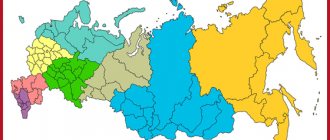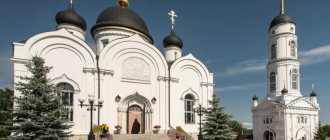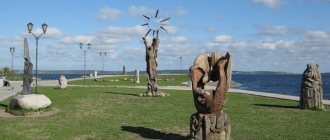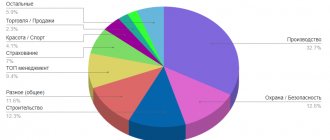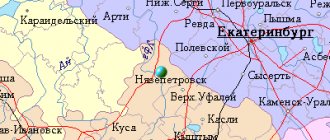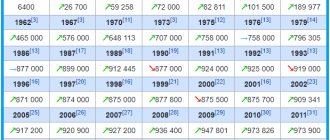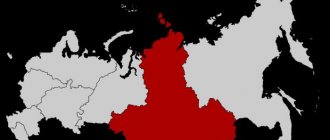TASS DOSSIER. On December 10, 2021, press secretary of the Russian President Dmitry Peskov announced that the head of state approved the proposal of the acting governor of the Primorsky Territory Oleg Kozhemyako to move the capital of the Far Eastern Federal District (FEFD) from Khabarovsk to Vladivostok. This decision will be formalized by a separate order from the Russian President.
The editors of TASS-DOSSIER have prepared material about the administrative centers of federal districts and the procedure for their transfer.
The center of the federal district is a settlement in which the plenipotentiary representative of the head of state, his apparatus, and various coordinating bodies are located. In addition, departments of federal ministries and departments may be created in the capitals of federal districts. Decisions on their establishment are made by government agencies themselves.
Actual information
According to official statistics, this figure for the Russian capital in 2021 is 2561.5 sq. km., inside the Moscow Ring Road - 900 sq. km. How much is this in hectares? To answer this question, you need to convert kilometers to hectares. According to the calculation method, 1 sq. km. corresponds to 100 hectares. This means that the area of the first throne in hectares will be 256,150 hectares.
The length of the Russian capital from north to south reaches 38 km within the Moscow Ring Road, and taking into account the territory beyond the Moscow ring road - 51.7.
The population of the city as of 2021 is 12679078 people, and in total 17200000 people live in the Moscow agglomeration. Moscow ranks first among Russian cities in terms of population. Among European cities it is also a leader in this indicator. Population density - 4880 people per square meter. km. This means that there are 4.88 people per square meter.
Coats of arms of federal cities
The type of coat of arms of Moscow that you can see now was approved in 1993. This is a dark red heraldic shield, which depicts St. George the Victorious on horseback. He pierces the black serpent with a golden spear. The serpent symbolizes the conquerors who tried many times to seize Russian land. The rider is a fighter for the country’s freedom and justice.
The coat of arms of Sevastopol is also a shield in shape, but two-colored. It consists of two fields, blue and white. They are connected by a golden laurel branch, symbolizing the defenders of Sevastopol. In the lower left corner of the coat of arms there is a monument to sunken ships. And at the top right is the Gold Star medal.
The shape of the coat of arms of St. Petersburg also resembles a red shield. This color was not chosen by chance. It symbolizes the blood shed in the Northern War. The shield depicts two anchors, two-bladed (sea) and four-bladed (river). And in the center is a golden scepter. Attribute of imperial power.
Subscribe to Migranta Rus: Yandex News.
Changes
The size of the city of Moscow has been constantly growing since its founding. But this increase took place not only as a result of the mechanical expansion of urban development, but also as a result of administrative decisions to incorporate new areas into the capital.
The largest administrative expansion of the Russian capital occurred in 2012, when the territories of the so-called “New Moscow” (otherwise known as “Big Moscow”) were annexed to the city. As a result, if in 2010 the area of the territory was 1077 sq. km., then in 2012 it was already 2510. That is, the total area of “New Moscow” is approximately 2.5 times larger than the “old city”.
Moscow
I moved to Moscow 4 years ago. Before this, I had only been passing through Moscow once, and it immediately seemed very large, majestic, and rich to me. The city was filled with enormous possibilities. I admit, I couldn’t wait to return as soon as possible, maybe someone knows this feeling, I couldn’t even bring myself to return to my city for things and so on. Then it seemed that only here I could breathe deeply. Of course, everyone in Russia knows that all the country’s money flows to Moscow, and the opinion that Muscovites are “snickering” is very firmly rooted in the heads of people from other cities in our country. I will say this, indeed, Moscow is a very rich city, but all the money flows not into the pockets of Muscovites, but into the pockets of the “powerful” citizens. Of course, there are many more opportunities here, and people with good brains and talent will definitely find a place and a job for themselves. But I want to dispel the myth about the fabulous salaries that everyone shouts about. The average salary in Moscow is 30,000-45,000 rubles. I’m talking now about the usual professions of sellers, security guards, administrators, managers, etc. To find confirmation of this, just go to hh. ru, and see what a deplorable state the labor market is in now. Another half of this should be divided into endless deception and “traps” of employers, which are very difficult to avoid. Therefore, you shouldn’t entertain the illusion that when you arrive in Moscow you can immediately “chop cabbage.” Everything is not so simple and fabulous. Of course, life in Moscow is not a cheap pleasure. The most important thing for each of us is the housing issue. And if you do not have your own home, then naturally this will become your first problem. Basically, all visitors live in rented rooms, hostels, rent a bed in a room, that is, they somehow try to save on housing. A more or less decent room in Moscow costs from 18,000-25,000 rubles. Agree, this is a huge part of your earnings, and at the same time you will live with people who are strangers to you, who have their own lives, their own habits, etc. I was lucky enough to bypass this option, but I lived for a year and a half in a hostel and saw it with my own eyes how families collapse in such conditions, where you are always shackled, deprived of basic living conditions. A forced environment makes people angrier, because constant discomfort simply does not give you the opportunity to keep your emotional system under control. Renting a full-fledged home is, of course, a more convenient option; the price of a 1-room apartment starts from about 28,000 rubles (plus cash), mostly these are housing far from the metro with grandma’s renovation. Now I am in the process of moving and am currently looking for an apartment. For people who have not yet encountered this, I would, of course, advise to resort to the help of a realtor, a trusted one with a good reputation. Be prepared that you will have to pay triple the cost of payment, respectively, monthly payment, deposit, commission to the agent, but this is better than looking for a cheap option and being left completely without everything and with burning tears in your eyes. Moscow is a beautiful city, and almost 24 hours a day on television they show how beautiful the streets are, what large-scale work is being done to expand the transport structure of Moscow and the Moscow Region, and so on. But not everything is as wonderful as it seems. Having lived here, I realized that Moscow is one big set, a props, so to speak. The authorities are engaged in endless cutting of the budget, which has no effect on the quality and standard of living in Moscow. The story of endlessly rearranging tiles has become a global meme. But in fact, this is not even funny, all of Moscow is an endless construction site, summer and spring begin and everything around is dug up, blocked off, dug up. It would seem that just yesterday there was a wonderful children’s playground in front of my window, with trees, carousels, excellent landscaping all around with a good road and sidewalk. But no, someone needs to master the budget, and certainly demolish all this beauty, and then dig, drill, dust, etc. for months in order to install a poor swing, leave the yard without landscaping and lay out crooked roads. And so that's it. In Moscow, parks and forested areas are being cut down endlessly, people are fighting as hard as they can to save nature, the animals living there, etc., but everything is useless, despite everything, including the laws of the Russian Federation. Green areas in the city are slowly being destroyed, while logging is absolutely illegal. Soon there will be nothing left except shopping centers and dense buildings, in which it is simply impossible to exist. Greenpeace provides data that over the past 12 years, more than 800 hectares of parks, squares, etc. have been cut down. Just think about this figure, essentially the lungs of the city have been destroyed. And the phrase that you don’t even need to travel outside of Moscow is absolutely real. Forest areas are truly “tidbits” for developers and thieves. And I can’t even imagine what our children will breathe in 5-10 years. Hence the huge number of chronic diseases that people simply turn a blind eye to. Today everyone is talking about the “wonderful” Disneyland - “Island of Dreams”, where the President himself came to the opening. A place that is promoted on all TV channels as the pride of the country. So this pride is nothing more than a tasteless, incompetent building, or rather a shopping center that no one needs. But because of this, a huge forest park area was destroyed - the Nagatinskaya floodplain, in which many living creatures lived, some species of which were listed in the Red Book. This is the real Moscow and what is happening here. Giant anthills are being built everywhere. I was lucky enough to live most of the time in the excellent Tushino area, which I simply adore. These are mostly old buildings, many canals, rivers, ponds, embankments, and the beautiful Pokrovo-Streshnevo park. But there are very few such areas in Moscow and mostly these are endless high-rise buildings, from the small windows of which you can see the same high-rise buildings. To be honest, living in such areas is very difficult, this is a real ghetto, a depressive and inhumane environment that gives rise to a marginal society. This has long been a proven theory, and unfortunately no one is going to solve this problem, but on the contrary, they are trying to “squeeze” as much as possible out of every piece of Moscow land. Air is a separate global problem for this city. Four times more people die from dirty air in Moscow than from accidents. This is a terrible statistic and we are second only to China and India in this horrifying fact. How do you like this information? Personally, it gives me goosebumps. Oxides, dioxides of sulfur and nitrogen, man-made dust, benzenes, etc. I won’t tell you how exactly this affects the body, everyone probably guesses that you definitely won’t get healthier from this. And in addition to all this, there are landfills, waste incineration plants, hazardous chemical waste processing plants, industrial facilities where various accidents and harmful emissions into the atmosphere occur every now and then. All these emissions endlessly settle on the mucous membranes of the respiratory tract, subsequently forming asthma, bronchitis, and asphyxia. And then, these are rather one of the “best,” so to speak, outcomes. Burning garbage is a separate and very global problem of the city; after burning, all poisons are released, including heavy metals and mercury. Simply put, the situation is dire and is only getting worse every day. The only thing that can be advised at the moment is to at least carefully choose your place of residence in order to be at least a little removed from all this environmental chaos. But despite the above, not everything is so bad in Moscow, and domestic and environmental problems are problems that can be encountered in any other city. For me, Moscow is one of the few places in Russia where you can at least somehow express your civic position. Of course, the consequences are sometimes dire, as many people know, but it is still important for me personally to be part of civil society. I deliberately skipped all the everyday stories about Moscow, or rather the shops, night and day life in this city, it is certainly rich and multifaceted, and everyone will find leisure time here according to their interests. And this, of course, makes life brighter and more beautiful. The choice remains with everyone, and each of us chooses a place where he feels comfortable and happy. The main thing, remember, never be afraid to close a book that is boring for you, no matter how wonderful the reviews are about it. Try, travel, learn and certainly draw your own conclusions based on personal experience! But it never hurts to listen to other people’s advice.
Story
How has the square in Moscow changed in historical retrospect? The ancient settlement, which arose in the 11th century on Borovitsky Hill, was at first very small, but gradually expanded. In 1339-1340, under Prince Ivan Kalita, a wooden Kremlin was built. It was smaller than the modern one and had an area of only 19.9 hectares. At the end of the 15th century, under Grand Duke Ivan III, the modern Kremlin was built, which is known to every resident of our country. The size of the territory of this historical and cultural monument has not changed since then.
We must remember that behind the Kremlin walls there were settlements where traders and artisans lived. Therefore, the city itself has always had a territory larger than the Kremlin.
After the formation of the Russian centralized state, the capital became its largest trade and economic center. After moving the capital to St. Petersburg, it remains the second most important city in the country. In 1918, Moscow again became the main center of our country.
The territory expanded quite quickly. In 1879 the area was sq. km. 79, in 1917 - 233.9, in 1939 - 326.2, in 1979 - 878.7, in 1989 1071.9, in 2010 - 1077.
Sevastopol
Sevastopol was founded at the end of the 18th century. This city is located on the coast of the Black Sea, so for residents of Russia this place is often a resort, and many even dream of living here.
This place is also interesting because it is on the territory of the city that the main naval base of the Black Sea Fleet of the Russian Federation is located.
It is on the territory of Sevastopol that the main naval base of the Black Sea Fleet of the Russian Federation is located. Photo: Pixabay.ru
A little history
Sevastopol is a city imbued with the spirit of history. As soon as Crimea (then Sevastos) was annexed to Russia, it became the base for ships of the future Black Sea Fleet. In all wars, Sevastopol played a very important role; first of all, it performed strategic and defensive functions. During the Great Patriotic War it was destroyed almost to the ground!
By the way, what there is a lot of in Sevastopol is inner-block courtyards, hills, descents, stairs, ascents - it is because of this that the city looks completely different from each new point.
Sevastopol is famous not only among Russian citizens. For example, one of the central streets of the French city of Paris is called Sevastopol Boulevard.
If you came to this beautiful city just to stay, then you should definitely visit 3 attractions:
- The ancient city of Chersonesus (or rather its remains). By the way, we recommend taking a full guided tour. Then you will definitely be very impressed!
- Monument to sunken ships. This monument clearly reflects many historical pages of the city, revealing Sevastopol as the main naval base.
- Count's pier. It’s just a very picturesque place where not only tourists, but also city residents want to get to.
Good environment, but expensive housing
If we consider this place to live, then the definite advantages of living here include the sea, the sun and the comfort of the city. Wide streets, favorable geographical location for traveling along the entire coast, active efforts to restore roads. It is worth noting that Sevastopol ranks 14th in terms of living standards among all cities of the Russian Federation. Due to its favorable geographical location, this city is perfect for lovers of good environmental conditions.
Due to the fact that the city is a subject of the Russian Federation, a large amount of money is invested in it: this money does not go away just like that - active work is being carried out on the reconstruction of cultural objects, work on the development of new buildings and roads. Every year more and more new parks, embankment designs, beautiful terraces, etc. appear.
Video: Timelab Pro
True, you can’t do without minuses either. Very expensive housing and minimal choice of jobs. High prices for food, comparable to Moscow.
Comparison
What are the indicators of the territory in comparison with other cities in Russia, Europe and the world? In Russia, the capital clearly ranks first in this parameter. The closest competitor is St. Petersburg, more than half the size.
In Europe, the Russian capital also ranks first in terms of territorial size. London, England, is in second place with an area of 1,580 sq. km.
In the world, its indicators are far from leading. It is not even included in the top ten largest cities by this parameter. Asian countries are completely in the lead here. Let us remind you that the largest area in the world is occupied by Chinese Chunqing (82,300 sq. km), Hangzhou is in second place (65,460), and Turkish Konya is in third place (38,873).
Moscow is the largest city in Russia in terms of population and territorial size. According to the above indicators, it ranks first in Europe. The city is developing very dynamically and the values of these parameters will only increase.
At the same time, our capital is significantly inferior to such giants as Karachi, Chunqing, Shanghai, and Hanzhou both in terms of area and population. But is it worth getting upset about? Excessively large territory and population create great management problems and increase the load on infrastructure. This can lead to a significant decrease in the quality of life of city residents, imbalances in the development of regions of the country, and increased social tension in society.
Far Eastern District and initiatives to move its capital
The center of the Far Eastern Federal District is Khabarovsk, the capital of the Khabarovsk Territory. The city houses the office of the plenipotentiary representative of the head of state, as well as a number of territorial bodies of federal authorities in the Far Eastern Federal District: departments of the Ministry of Culture, the State Courier Service, the Pension Fund of the Russian Federation, the department of Rosprirodnadzor, the Far Eastern Investigation Department for Transport of the Investigative Committee of the Russian Federation, the Far Eastern Interregional Territorial Department air transport of the Federal Air Transport Agency, the Far Eastern Directorate of State Railway Supervision of the Federal Service for Supervision in Transport and others. Previously, the Regional Border Directorate of the FSB of Russia for the Far Eastern Federal District, the Main Directorate of the Ministry of Internal Affairs for the district, and the Federal Directorate of the Ministry of Justice of the Russian Federation for the Far Eastern Federal District also operated in Khabarovsk.
On October 6, 2021, Acting Governor of the Primorsky Territory Oleg Kozhemyako took the initiative to move the administrative center of the Far Eastern Federal District from Khabarovsk to Vladivostok. This idea was supported by Prime Minister Dmitry Medvedev, Presidential Plenipotentiary Envoy to the Far East, Deputy Prime Minister Yuri Trutnev and Chief of the Russian Presidential Administration Anton Vaino.
On October 9, 2021, Yuri Trutnev announced that by the end of the year, President Vladimir Putin will be asked to consider the possibility of giving Vladivostok the status of the administrative center of the Far Eastern Federal District. According to Trutnev, the basis for the transfer is that in terms of investment attractiveness and development opportunities, Primorye “is already really the capital of the Far East.” He recalled the implementation of the Zvezda shipbuilding complex project in the region, enterprises in the field of agriculture, projects for the construction of the Nakhodka Mineral Fertilizer Plant and the Eastern Petrochemical Complex. Potentially, these projects are several times greater than the volume of new projects being implemented in the Khabarovsk Territory.
Geographical position
The geographical location of Moscow and the region is the central European part of Russia. In size, the territory can be compared with the area of an entire state, for example, Luxembourg. The country's capital is located in the UTC+3 time zone (the difference with London is +3 hours).
The city was built on both banks of the Moscow River, in its middle course. Other watercourses flow in the capital, including Khimka, Yauza, Presnya, etc. In addition, there are many lakes and ponds.
Main features of the physical-geographical position:
- Good agroclimatic conditions.
- The capital has a large transport interchange.
- The city is located between the Oka and Volga rivers.
Through river routes it is possible to access the Arctic and Atlantic oceans.
Relief features
Moscow is located in the central part of the East European Plain and its relief is very diverse. The city is located in the Smolensk-Moscow Upland and the Meshchera Lowland. On the territory of the latter there are many swamps. The highest point is in the southwestern side , within the boundaries of the Teplostan Upland. The largest part of the capital is covered with a thick layer of Quaternary sediments.
According to legend, the city was built on seven hills, like Rome and Constantinople. This is actually true. Moscow hills: Tagansky, Borovitsky, Tverskoy, Sretensky, Lefortovo, Trekhgorka, Vorobyovy Gory.
These names were first listed in a reference encyclopedia in 1980. If you count all the other hills, there are more than 20 of them.
Weather
The capital of Russia is located in a zone of temperate continental climate. In such conditions, the change of seasons is clearly visible. There is a difference of more than 25 degrees between the average temperatures of the warm and cold seasons.
In the summer in Moscow it is sunny and sometimes sultry, in the fall it starts to get cold and it rains. In November and December it is most often slushy, and closer to the New Year frosts begin. Heavy snowfalls do not occur so often , on average 2-3 times per month.
Typically, about 700 millimeters of precipitation falls in the capital per year. The largest amount occurs at the end of summer, and the smallest at the beginning of spring. The number of sunny hours per year is 1731. The clearest month is July. The fewest sunny days are November and December.
Soil cover
In the capital, natural soil cover has been preserved only in a few places, since construction work is underway almost throughout the city. Between the tributaries of the Moscow River there were predominantly soddy-podzolic soils. In the northern and western parts, according to the description, they are clayey. The river valley has fertile meadow-boggy soils.
More or less soil cover was preserved in forest parks where nature remained practically untouched - Bitsevsky, Losinoostrovsky, Kuskovo and some others.
To describe it in general terms, the city occupies a very advantageous location. Thanks to this, the capital is a central and important economic and geographical region of Russia.
The geography of Moscow and what plain it is on is often studied in school lessons. Often they are asked to write a message or essay on this topic.

